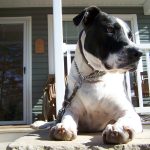
Many dogs are, by nature, possessive and sometimes aggressive about food. This can create problems in an otherwise peaceful home. While all dogs should have their own dish at feeding time – to control portions – treats and toys sometimes involve sharing.
If there are multiple dogs in the home, each needs to be able to accept small treats without getting grabby; trying to steal another dog’s treats. Durable treats like chew bones will last a long time, that means sharing them. People and dogs need to know who is alpha and behave accordingly.
Of course the Peoples are uber-alpha, but among us dogs we will have our social order as well. Once we all agree on that order, peace can be maintained. Problems come when more than one dog thinks it’s in charge. Being possessive about food is not so much about hunger as it is about control. Once we all agree that I’m the big dog, I can be magnanimous by sharing.
Of course, the fact that none of us is starving helps.
Training and Sharing
In the wild, dogs use control of resources (food, for example) as a social tool within the pack. The pack leader decides who gets what – and who does not. Typically, the leader will demand first crack at some new resource. In People homes, this tendency extends to toys, beds and space, as well as food. But in a home setting, you (the Person) must be the leader and must take control of all things the dog might want.
As the pack leader, it is you who decides who has what, when and where – even if you have only one dog. Your pack might be small, but you need to be the leader. If the dog thinks she is in control, you will have a growly, demanding and potentially biting dog. The dog must never feel she in control of her food, her toys, her bed, or her space in your home. The dog must view you as the leader of the pack. If you can take food away from her without a negative reaction, then you can be sure she regards you as her leader. That is good.
If you have more than one dog, one of them will inevitably try to take over as the leader. He will claim dominance of the other dog at least, if not of the entire pack; which includes you. That is bad.
Eliminate Hormones
One thing that helps a lot in eliminating leadership disputes, especially with male dogs, is to have the dog fixed (neutered or spayed). Removing the hormonal influence goes a long way toward removing undesired behavior like marking territory and dominance aggression. It may take a little time to see a change in an adult dog, but you will see a change. Unless you’re going to breed the dog (and I’d urge you to think carefully about that) there is no reason not to spay or neuter your pet.
Establishing Your Dominance
Establishing your position as pack leader in the dog’s mind means putting the dog into a submissive role, but this does not need to be done with brute force. Positive reinforcement works far better when used consistently and properly. Knowing that you will reward them for good behavior goes farther than keeping them in fear of punishment.
First, never try to train a dog when you are in a volatile mood. If you are angry or exasperated about something – even something unrelated to your dog – the dog will pick up on your mood and be uncomfortable. She doesn’t know someone cut you off in traffic on the way home, she only knows you’re angry. Establish calm first.
A good way to start with a new dog is to withhold his food dish until he complies with some command. Teaching a dog to sit is fairly simple, teach him that first, then hold the food dish out and tell him to sit. When he complies, put the food dish down and allow him to eat. Do this consistently and he comes to realize that you are the giver of food and he needs to obey you to receive food. You are the pack leader.
As you progress, when a child, another person, or pet in your home approaches her when she’s eating or chewing on a toy or treat, reward her for not growling, even if it’s just with a scratch of the ear and “good girl”. Make her know you are happy with her when she is non-aggressive.
If you have multiple dogs and one is food aggressive, feed that one in his crate. Do this within vision of the other dogs, but far enough away to reduce the threat he feels from the other dogs. Your dog should already think of his crate as his safe place. As the new one gets accustomed to the idea that you give out the food and everyone gets a share, you can ease the crate closer to the other dogs. As tensions ease, put his dish down just outside crate. Eventually all dogs will be able to eat in close proximity without nastiness or attempts to steal food from the others. In time, competition for toys and treats will disappear and they will be able to play together constructively, sharing these resources.
In Extreme Cases
If you have an especially willful dog – perhaps an older dog that has had no training — training her to respect you as the leader and commander of all things may require a stronger measure. Always try positive reinforcement first, but if you must: keep a little spray bottle of water handy. If she gets aggressive with you, give her a quick spritz in the face during a growl or even a lip-curl. Don’t make a big thing of it, as this is a form of attention and she may use this tactic to get you to pay attention to her again. Just use it to redirect her attention so you can again use positive reinforcement to reward good behavior.
| If you enjoy our updates, Doggy Tales, and educational articles consider subscribing for notices when new pieces are posted. It’s painless and you can unsubscribe any time you want. Your e-mail address is used ONLY to deliver these notices. | [email-subscribers namefield=”YES” desc=”” group=”Public”] |




One comment on “Good Dogs and Sharing”
Comments are closed.